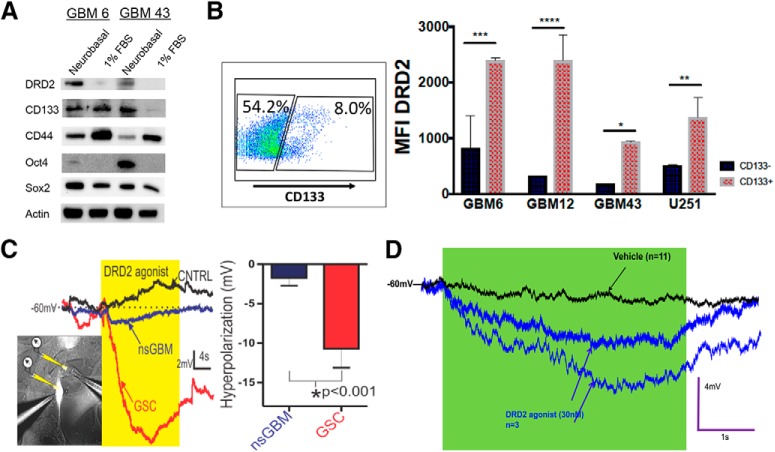Figure 2.
Glioma initiating cells preferentially express DRD2 and specifically respond to receptor activation with hyperpolarization. A, Two different subtypes of PDX lines freshly isolated from animals were cultured in tumor sphere maintenance media (neurobasal media containing EGF and FGF) or differentiation media (DMEM containing 1% FBS) and subjected to immunoblot analysis for the expression of DRD2 and various GIC markers. B, PDX cells were subjected to FACS analysis for GIC marker CD133 and DRD2. Using controls, we established gates for CD133+ and CD133- populations. We then quantified the mean fluorescence intensity (MFI) for DRD2 expression in each of these populations. C, Human glioma U251 cells expressing RFP under the control of the CD133 promoter were patch-clamped and electrophysiological recordings were taken during exposure to highly selective DRD2 agonist. Puffing DRD2 agonist (30 nm; yellow) onto fluorescently labeled GIC (brightly labeled cell, left; red membrane potential trace, middle) induces a more robust hyperpolarization of the membrane potential (mV) than non-GICs exposed to the same agonist (nsGBM; non-labeled cell, left; blue trace, middle), or versus puffing vehicle control (n = 4 each). Graph: DRD2 agonist hyperpolarizes GIC more strongly than non-stem GBM cells (right). D, Electrophysiological recordings of PDX cells confirms that only certain cells respond to the agonist with hyperpolarization. Bars represent means from three independent experiments and error bars show the SD. Student t tests were performed for each day separately. *p < 0.05, **p < 0.01, ***p < 0.001, ****p < 0.0001.

